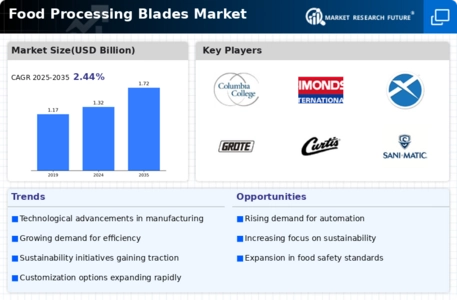Focus on Food Safety and Quality
The increasing focus on food safety and quality is driving the Food Processing Blades Market. Regulatory bodies and consumer awareness regarding food safety standards have heightened the need for reliable processing equipment. Blades that ensure precise cutting and minimize contamination risks are becoming essential in food processing operations. Market data suggests that investments in food safety technologies are expected to rise, with companies prioritizing equipment that meets stringent safety regulations. This trend not only enhances consumer trust but also compels manufacturers to innovate their blade designs to align with safety standards, thereby fostering growth in the Food Processing Blades Market.
Growth of the Food Service Sector
The growth of the food service sector is a significant driver for the Food Processing Blades Market. With the rise of restaurants, catering services, and food delivery platforms, there is an escalating need for efficient food processing equipment, including high-quality blades. Recent statistics indicate that the food service industry is anticipated to expand at a rate of around 6 percent annually, creating a robust demand for food processing solutions. This growth necessitates the use of specialized blades that can handle various food types and processing techniques. As food service providers strive to maintain quality and efficiency, the Food Processing Blades Market is poised to benefit from this upward trend.
Rising Demand for Processed Foods
The increasing demand for processed foods is a primary driver of the Food Processing Blades Market. As consumer lifestyles evolve, there is a noticeable shift towards convenience foods, which require efficient processing techniques. This trend is reflected in market data, indicating that the processed food sector is projected to grow at a compound annual growth rate of approximately 5.5 percent over the next few years. Consequently, the need for high-quality food processing blades becomes paramount, as they play a crucial role in ensuring the efficiency and quality of food production. Manufacturers are thus compelled to innovate and enhance their blade technologies to meet this rising demand, which in turn propels the growth of the Food Processing Blades Market.
Emergence of E-commerce in Food Distribution
The emergence of e-commerce in food distribution is reshaping the Food Processing Blades Market. As online grocery shopping and food delivery services gain traction, there is a corresponding need for efficient food processing solutions that can cater to increased demand. E-commerce platforms require food products that are not only fresh but also processed efficiently to ensure timely delivery. This shift is prompting food processors to invest in advanced blade technologies that enhance processing speed and maintain product quality. Market trends indicate that the e-commerce food sector is likely to continue expanding, which will further drive the demand for innovative food processing blades, thereby positively impacting the Food Processing Blades Market.
Technological Innovations in Blade Manufacturing
Technological innovations in blade manufacturing are significantly influencing the Food Processing Blades Market. Advances in materials science and engineering have led to the development of blades that are not only more durable but also more efficient in their cutting capabilities. For instance, the introduction of high-performance alloys and coatings has improved blade longevity and reduced maintenance costs. Market analysis suggests that these innovations are expected to drive a substantial increase in blade performance, with some manufacturers reporting efficiency improvements of up to 30 percent. As food processors seek to enhance productivity and reduce operational costs, the demand for technologically advanced blades is likely to surge, further stimulating the Food Processing Blades Market.

















Leave a Comment